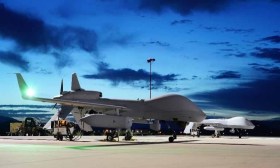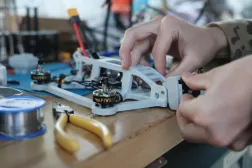Army drafts new electronic warfare concepts for above and below division

The Army has drafted and presented new concepts of operations for its slew of electronic warfare equipment to senior leaders.
After divesting much of its capabilities after the Cold War and lacking any program-of-record offensive or defensive EW equipment during the post-9/11 wars, the Army is now poised to begin fielding a raft of capabilities to its forces and formations.
With the introduction of these new systems, the service needs concepts of operations for how those tools — which will include ground-based jammers for formations above and below brigade, backpacable jammers and airborne jammers — will be deployed and used within formations.
“The Army’s plan is to develop and employ integrated EW capabilities that provide ground commanders at echelon with the ability to see themselves, see the adversary, and affect the adversary through the” electromagnetic spectrum, Col. Gary Brock, Army capabilities manager for electronic warfare at the Cyber Center of Excellence, said in response to questions from DefenseScoop. “The overall objective is to develop EW capabilities that serve as a force multiplier to counter extant and emerging threats. We must take advantage of opportunities to detect, deny, deceive, disrupt, degrade, and destroy EMS capabilities upon which our adversaries rely, while also maintaining our own EMS awareness to ensure freedom of maneuver in contested and congested environments.”
As part of a Warfighting Forum that took place at Army Cyber Command in late-February, documents detailing how the Army will fight with electronic warfare tools at the corps level and above, and division and below, were drafted and presented to Army Cyber Command, Cyber Center of Excellence and senior service leaders, according to Brock. The documents were developed with input from the operational and institutional forces and are living documents that will be continuously updated as new EW systems are approved and fielded, he added.
The concepts were completed as part of the Army Capabilities Development Integration and Development System (ACIDS)/Joint Capabilities Integration and Development System (JCIDS) process from 2013 with an organizational relook in 2016. It differs from the past as it’s taking a holistic look at the EW systems architecture the Army is crafting, as opposed to individual programs. Officials want an integrated system of capabilities that fit into a battlefield architecture with other Army systems.
It is also the first electronic warfare concept-of-operations document since the Army updated its doctrine for conducting battlefield operations, Field Manual 3.0, in 2022 that defined the division as the unit of action, not the brigade as it had been over the last 20 years.
The concepts will differ depending on complexity and echelon. For example, corps will focus on integration with joint and international partners, with divisions focusing on tactical engagement and maneuvering while enabling brigades.
Battalion and below formations will be transforming with electronic warfare integrated into new and emerging technologies such as robotics, drones and launched effects, Brock said.
“EW must remain adaptable and flexible in response to evolving threats in the EMS … The CONOPS also must maintain pace with the technological adaptations and advances,” Brock said. “The Army plans to equip Soldiers with modular EW equipment that can be rapidly updated to meet the threat and adapted to integrate with varying platforms, whether it is a manned aircraft, unmanned aircraft, or a robotic combat vehicle. Expendable and attritable systems will offer persistent EW coverage and make the battlefield more survivable.”
Brock noted that at the theater level the electronic warfare fight will largely be executed through the multidomain task forces, bringing another layer to the concept as they support the theater commanders’ anti-access and area-denial degradation priorities, which refers to the combination of advanced radar and long-range missiles that will push U.S. assets farther away from adversaries.
The MDTF concepts have theater-specific variations, Brock said, to include the Europe-based land scenario vice the Indo-Pacific scenario.
Corps will support divisions with long-range electronic warfare — to include high-altitude and long-range launched effects — but also through protection such as securing lines of communication.
Then, at division and below, the EW fight will focus on optimizing electronic warfare payloads to platforms to generate desired effects on targets, with integration at the machine level into the command and control and fires ecosystems at echelon remaining an imperative.






